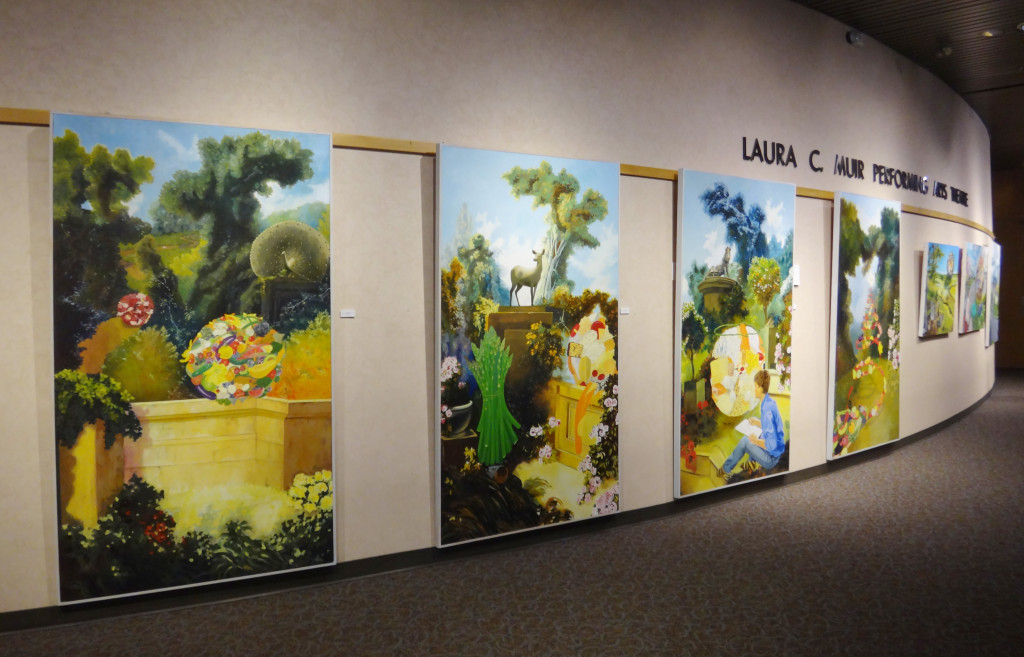Explores themes of consumption and art history
By Cheryl Minns, Arts Editor
Get ready for a feast as the Amelia Douglas Art Gallery presents Nicola Tibbetts’ Foods Behaving Strangely, which runs until February 14. The gallery walls are adorned with four series of realistic and fantastical food-related paintings that Tibbetts describes as her “stories, photographs, memories, and groceries.”
The Other Press spoke with Tibbetts about her work, her fascination with food art, and what she hopes Douglas College students will enjoy in this exhibit.
Could you describe how you created one of your food paintings?
[Tibbetts chose the piece The Feast: The Remains]
This is the final painting in a series of four that document a feast from beginning to end. In this one, the feast has been consumed and you’re sort of getting an idea of the excess that went on during the feast, although it doesn’t look totally grotesque because all the objects are uniquely portioned. There’s not a whole lot of gross dripping and what a pile of used food would actually look like. It’s more pleasant than that. I wanted to get across that idea of overconsumption, eating, and excess, but also still think it kind of beautiful and interesting to look at.
How did you decide which foods to include in the painting?
This is the last one I painted [in the series] and I had these three [other paintings] as a reference for some object that I wanted to include. Like, I have a black forest cake in [the third painting] and then I also included black forest cake in this one. I was painting my lunch, dinner, and breakfast throughout the course of a couple weeks in order to get piles in here. There’s oatmeal in the morning and then there’s bean soup here. I was working just with things that I was eating but also working off of the other objects that I had included in the other feast paintings.
I wanted them to be an equal distribution of meats and other foods because in the medieval feasting tradition, which is sort of my inspiration for the work, meat was such a big part of the food culture. I also wanted to include some objects that one would use in preparing the food and also to eat the food with, so that’s why I have the used dishes up top. And then throughout the series as well there appeared some references to art history, like the lemon peel for example I directly took out of an art history book idea from the 17th century.
Do you have a favourite food that you like to paint?
I really love painting meat. I am a vegetarian, but I do love painting meat because I love any food that has a saturated colour and texture and if it can have deep detail like meat does. I’ve always kind of been fascinated by meat aesthetically because it comes in all different colours of reds and pinks, and there’s fine lines from the muscle, and then there’s a little bit of bone, and sometimes a little bit purple or bloody or white from the fat. So I have to say, I do like painting meat.
Are there any other favourite foods that you like to paint?
It’s also really pleasurable to paint something like a beautiful desert because they’re just so pretty. I went to a French bakery and I picked up these little miniature French desserts and they’re really fun to paint because they’re just so delicate and beautiful.
How do you think your art will appeal to college students?
One thing I try to achieve is to have my work accessible to many different groups of people. I think there’s something that children could enjoy in this work because it’s bright and it’s big and there’s food. Food, first of all, is a subject that everyone can get something out of. University students, I think that they could begin to understand some of the depth that’s in the work, like the historical depth and some of the technical things that are going on in the work.
To learn more about Tibbetts’ work, visit her website at www.nicolatibbetts.com
Foods Behaving Strangely
Nicola Tibbetts
Amelia Douglas Art Gallery
Now – February 14

